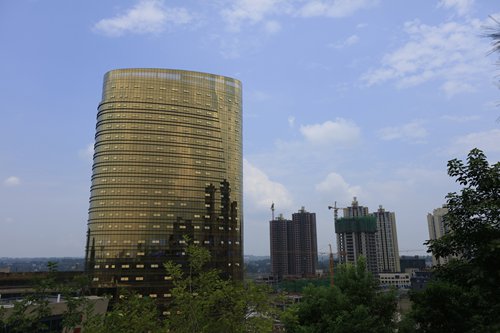 A building in Huaying, Southwest China's Sichuan Province, funded with an $86 million private investment, was completed in August. Photo: CFP
A building in Huaying, Southwest China's Sichuan Province, funded with an $86 million private investment, was completed in August. Photo: CFP
China's private investment grew in the January-September period of 2016, with 17 provinces posting higher growth than the national average.
Experts attributed the increase to encouraging measures from the central government, the rise in public-private partnership (PPP) projects and a recovery in the country's economy. Experts forecast further growth in 2017.
Of the 20 provinces that have released data on private investment as of Thursday, five provinces and cities including Northwest China's Ningxia Hui Autonomous Region, South China's Guangdong Province and Northeast China's Jilin Province lead with a growth pace of over 12 percent, domestic news portal cnstock.com reported.
The country's average growth rate for private investment in the first nine months stood at 2.5 percent, expanding 0.4 percentage points from the January-August figure, data from National Bureau of Statistics (NBS) showed in October.
In Jilin, private investment grew 12.7 percent, while the province's GDP reached 6.9 percent, surpassing the national average.
Jilin's abundant resources as well as the governments' various measures to streamline the administration and reduce corporate burdens helped attract investment, the Xinhua News Agency reported on Sunday. It also noted that ecological tourism and agricultural sightseeing in the region are new market areas that can be developed.
Private investment in the central and western regions also posted faster growth as labor-intensive manufacturing companies with high-energy consumption from the southeast of China transfer to these regions, Lian Ping, chief economist at Bank of Communications, told the Global Times on Thursday.
In the first nine months, the manufacturing sector saw just a slight increase in private investment but the property sector has been hot, said Xu Hongcai, deputy chief economist of the Economic Research Department under the China Center for International Economic Exchanges.
Reasons behind boost
"The implementation of large quantities of PPP projects boosted growth in domestic private investment, as about one-fourth of the projects are private investment," Lian noted.
There has been 745 demonstration PPP projects involving the third batch of 516 projects recently announced by the Ministry of Finance in October, a separate Xinhua report said on Sunday. An estimated 58.18 percent of projects involved in the former two batches had been implemented by September, rising 9.78 percentage points compared to the figure as of June, according to the report.
In addition, the domestic market environment is improving, encouraging companies to expand and invest, Lian said, noting that the country's macro-economic figures have been showing positive signs.
China's added value for large industrial firms rose by 6 percent year-on-year in the first nine months of 2016, data from NBS showed. The country's Producer Price Index (PPI) dropped 2.9 percent year-on-year during the same period, but PPI in September rose 0.1 percent year-on-year, ending contraction that started in March 2012.
The government's policies also served as an important factor for the improvement of private investment, Xu told the Global Times on Thursday.
The State Council, the country's cabinet, issued a series of documents to encourage private investment. Specifically, in July the cabinet sent a message to local authorities to guide their methods to boost private investment.
The cabinet and the National Development and Reform Commission (NDRC) sent teams to a total of 30 provinces to inspect local authorities' work on enhancing private investment, according to a statement on the NDRC's website in May.
Bright outlook
Domestic private investment is unlikely to slump in 2017. On the contrary, the figure is projected to reach 5 percent if the country's economy continues to stabilize, Lian from Bank of Communications noted.
"The manufacturing industry will remain stable as companies will increase production to replenish their storage. And property investment will not tumble in a short period of time because a reduction in property investment comes at least half a year after the drop in real estate sales," Lian explained.
He predicted private investment in the service sector is likely to rise as the government lowers thresholds.
The latest data from the NBS showed that private investment in the service sector stood at 11.98 trillion yuan ($1.7 trillion), up 1.2 percent year-on-year, expanding 0.2 percentage points compared with the January-August period.